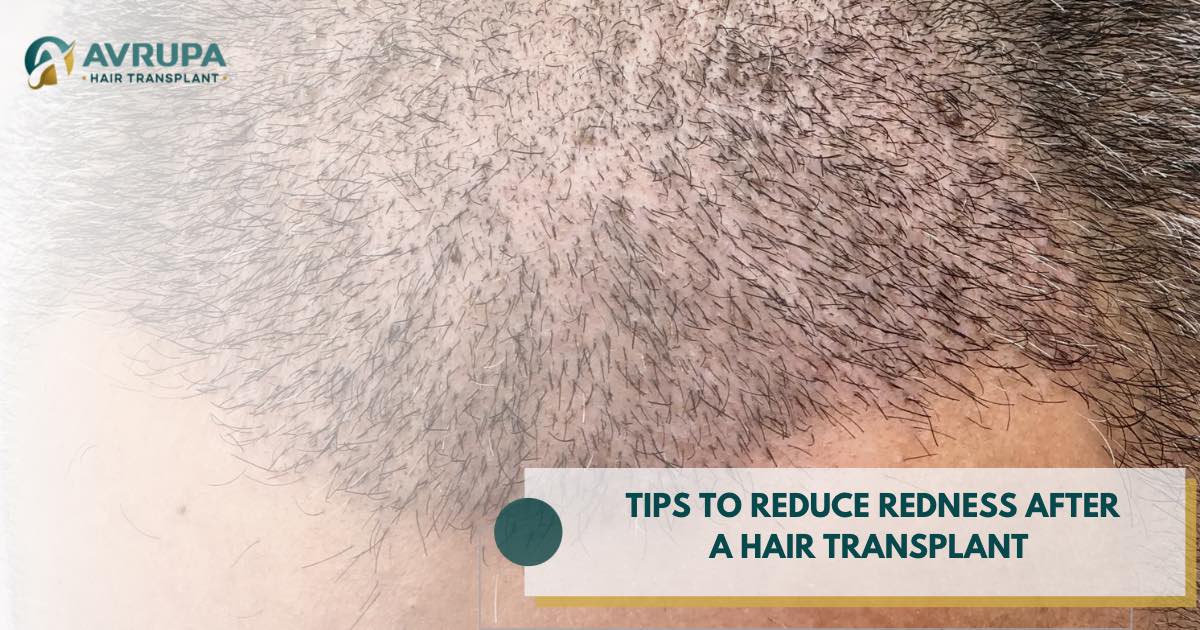
How to Reduce Skin Redness After Hair Transplant

October 23, 2024 by
Dr. Semra Akıntürk
Experiencing redness after a hair transplant is a common temporary side effect as the scalp heals from the procedure. While it’s a regular part of the recovery process, prolonged redness can cause discomfort and concern for many patients. Understanding the causes of post-transplant redness and how to effectively manage it can enhance your healing experience.
In this guide, we explain why skin redness occurs after a hair transplant, the best methods for reducing it, and how to care for your scalp in the days and weeks following your procedure. With the right strategies and aftercare, you can minimize redness and ensure a smooth recovery.
1. Why Does Skin Redness Occur After Hair Transplant?
The Post-op Healing Process of Hair Transplant
During a hair transplant, hair follicles are extracted from a donor area and implanted into the recipient site. This process triggers the body’s natural healing response, causing blood to rush to the affected area. The increase in blood flow leads to inflammation and redness, which is the body’s way of repairing the skin and promoting hair growth.
How Long Does Redness Typically Last?
For most people, redness begins to fade after a few days but may persist for up to two weeks, depending on skin type, sensitivity, and the scope of the procedure. However, it’s common for some individuals to experience mild redness for a few months, particularly if they have sensitive skin. Knowing that redness is part of the normal healing timeline can help ease concerns during recovery.
2. Post-Transplant Aftercare to Minimize Redness
Gentle Washing Techniques
In the days following your transplant, it’s essential to wash your scalp gently to avoid disrupting the healing process. Use a mild, sulfate-free shampoo as recommended by your surgeon, and avoid rubbing or scrubbing the scalp. Instead, gently pour water over the area and use light dabbing motions. This will help clean the scalp while preventing additional irritation.
The Importance of Hydration and Moisturizing
Keeping your scalp hydrated is essential for reducing redness. Use a gentle, fragrance-free moisturizer to keep the skin hydrated and prevent dryness, which can exacerbate redness. Drinking plenty of water also supports overall skin health, helping your scalp heal more efficiently.
3. Topical Treatments for Redness Relief
Soothing Gels and Creams
Look for products containing calming ingredients like aloe vera, calendula, or hyaluronic acid. These ingredients work to soothe irritated skin and reduce redness. Aloe vera gel, in particular, is widely recommended for post-transplant care because of its cooling and anti-inflammatory properties.
How Aloe Vera and Antioxidants Can Help
Aloe vera helps reduce redness by cooling the skin and reducing inflammation. Additionally, products containing antioxidants such as vitamin E or green tea extract can help protect the skin from further irritation while promoting healing.
4. Natural Remedies to Reduce Redness
Cold Compresses for Immediate Relief
Applying a cold compress to the scalp can constrict blood vessels, reducing redness and swelling. Use a soft cloth dipped in cold water or wrap an ice pack in a towel before applying it to the affected area. Be sure to avoid direct contact with ice on the skin, as this can cause further irritation.
Chamomile and Other Herbal Solutions
Chamomile is known for its anti-inflammatory and soothing properties. Applying chamomile tea compresses can help calm the skin and reduce redness. Other herbal remedies, such as witch hazel or calendula, may also help soothe irritation and promote healing.
Note: Always consult your treating hair transplant doctor before attempting to self-treat or use any DIY remedies.
5. Avoiding Common Triggers of Prolonged Redness
Sun Exposure and Heat
Direct sun exposure can inflame your scalp and exacerbate redness. After a hair transplant, it’s critical to avoid the sun for at least a few weeks. If you need to go outside, wear a hat or use a scalp-friendly sunscreen with high SPF, as recommended by your doctor. Heat from hot showers or saunas should also be avoided as it can dilate blood vessels and increase redness.
Preventing Irritation from Hair Products
During recovery, avoid using hair styling products such as gels, sprays, or harsh shampoos that could irritate your scalp. Opt for gentle, sulfate-free products that won’t disrupt the healing process. Stick to your surgeon’s recommendations for post-transplant hair care to avoid unnecessary irritation.
6. When to Consult a Doctor About Prolonged Redness
Signs of Infection or Inflammation
If redness is accompanied by swelling, pain, or pus, it could be a sign of infection. In these cases, it’s essential to consult your doctor immediately to prevent complications. Prolonged redness with itching or heat may also suggest inflammation or an allergic reaction to hair products or medication, which requires professional evaluation.
Knowing When Redness is Beyond Normal
If redness persists for more than a few months or is worsening over time, it’s a good idea to contact your surgeon. They can assess whether additional treatments or medications are needed to manage the redness and support your recovery.
Conclusion
Reducing skin redness after a hair transplant is a key part of the recovery process. By following proper aftercare routines, using soothing treatments, and avoiding common irritants, you can help your skin heal faster and minimize redness. Remember, redness is a natural part of healing, but with the right care and attention, it can be reduced, allowing you to enjoy the full benefits of your hair transplant.
Written By
Dr. Semra Akıntürk
Dr. Semra Akıntürk is a renowned dermatologist based in Istanbul, Turkey. With extensive training and experience in skin health and hair transplant, she specializes in various dermatological treatments, including cosmetic procedures and skin disease management. Dr. Akıntürk is known for her patient-centered approach, utilizing the latest advancements in dermatology to provide personalized care. She is actively involved in continuing education and often shares her expertise through workshops and publications, contributing to the broader medical community.